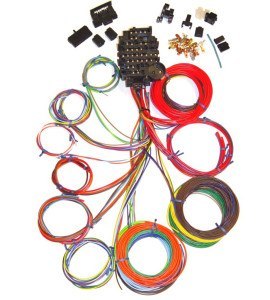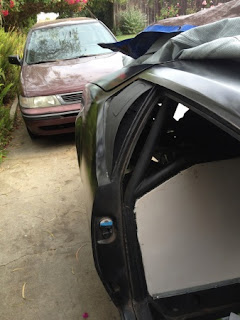I used their 18 circuit system that set me back around $300. Here's a shot of the system along with a link to their web site. http://www.hotrodwires.com/product/18-circuit-harness.html

I also ordered a wiring diagram for the car I took the ignition switch module from. It took a little digging but having the wiring diagram is critical to marry up the wiring system to the ignition, turn signal, horn, headlights and windshield wipers. After carefully attaching each of the Hot Rod Wires to the ignition module, I'm actually able to turn the engine's starter motor using the ignition key. That's some good progress.
Here's a picture of the "rat's nest" of wires that I am working with. When I have every thing hooked up and tested I will do a little beautification work to get it all looking the way I want it to.
HEADLIGHT DOORS
After getting the ignition module hooked up I decided to tackle the headlight doors. The previous owner had already installed the opening motor and limit switches and had a bundle of wires coming from each connection. After a little digging I found several wiring diagrams for the original Pantera. Now the fun begins.
I said earlier, I'm not an expert at wiring up anything. But, after restoring several cars now, wiring is something I just had to figure out. After staring at the original Pantera wiring diagram for the headlight doors, I saw that I was going to have to get creative with the relay setup. I had already pulled a small power distribution box from a small Ford at the junk yard. This box came with slots for four relays. I already knew that I was going to mount this thing in the front boot and use it to control the headlight doors and the radiator fan. Now I needed to figure out how to make the doors work. Here's a shot of the power distribution box I'm using.
Relay 1&2 are used to control the headlight doors. Relay 3 is for the fan motor. The fourth slot is open for some other circuit that needs a relay in the future.
I saw on the original wiring that they used a double throw relay for the headlight doors. I never used anything like this and didn't have the place to mount such a thing. I came up with the following scheme to use normal relays to do the same thing as shown in the original wiring diagrams. The first diagram shows the current path for when the headlight switch is turned on. The second one is when the headlight switch is turned off.
Great in theory, but will it work. I soft wired everything up and, can you believe it, the doors go up and down as I had hoped! I then hard wired it all up and again, it worked perfectly.
More will come on wiring as interesting things arise.
























.jpg)
.jpg)
.jpg)
.jpg)
.jpg)
.jpg)
.jpg)
.jpg)
.jpg)